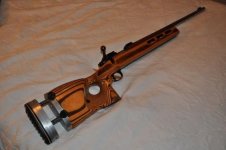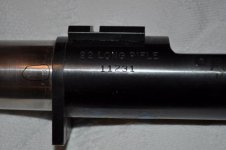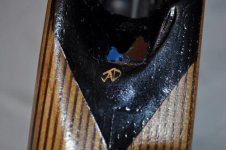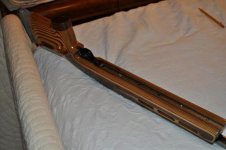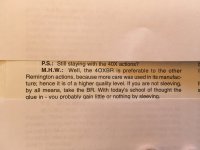More info is needed to answer your question. I will paste somme general info on the 40x series that my help you get started in your search.
The Remington 40-X Rifle
A legend in it's own time
08 October 2001
By Paul "Pablito" Coburn
The 40-X series of rifles have been with us for about 40 years. The 40-X was the brainchild of Mike Walker, one of "Big guns" of Remington in the 1960's and an avid benchrest shooter.
He wanted Remington to have a "factory" target rifle that would beat anything in the field, including the famed Winchester M70/Target-Match.
Started in the early 60's, the 40-X line has expanded over the years to include rifles well suited to longrange target, Varmint shooting, military sniping, and benchrest shooting.
There are now two series of 40-X: the Match/Varmint rifles, and the Benchrest rifles, and contrary to popular belief, there ARE distinct differences between the two.
Each 40-X series rifle comes from the factory with a test target of two groups. The average of these two groups must meet the specifications required... about .75" for 30 cal rifles, and about .45" for the smaller calibers. Keep in mind that these groups are just "proof groups", and no indication of what the rifle is capable of. Nor is the load written on the target, a special load for that gun. Remington has standard loads for each caliber that they use to test the guns. These are NOT the best loads for the gun, so don't be disappointed if your new .308 40-X has two groups of 3/4"... it is capable of under .20" all day long.
All of the Match/Varmint Grade 40-XBs, regardless whether single shot, or repeater, are marked (Stamped!) 40-X on the left side of the receiver, opposite of the ejection port. The "B" part of the designation is the last digit of the serial number, as in "XXXXXX B".
There are NO match rifles marked "40-XB".
The first 40-X rifles had carbon-steel receivers and cro-moly barrels. These date in from the early 60's. By 1965, the barrels were stainless. Some years back (I don't know when), Remington switched to stainless steel receivers for the 40-XB Match/Varmint Rifles (but not for the benchrest rifles).
All 40-X series rifles are made on the short action. There never was a long action 40-X.
In the early years, there were two barrel weights, both 27.5": a medium (similar contour to the Varmint Special, but longer) called the H-1, and a straight heavy barrel called the H-2 (the current barrel). Now there is only one contour, the straight heavy barrel.
The 40-series rifles are available in single shot and repeater configurations. Of the repeaters, ONLY the .308 repeaters are clip slotted at the factory... If you order a repeater in another caliber, like .223 or .22-250, it is not clip slotted.
The receivers use the same barrel threads and same dimensions as the standard actions, BUT the 40-X series receivers are NOT taken from the standard production line and "trued"; they are made (and serial numbered) in a different facility.
The actions are NOT "blue printed" (there is no such thing as a blue printed action, no matter what your local 'smith says!). They are simply made true and square to spec, from the start. All the 40-X rifles I've owned had both lugs mated, all screw holes were true and in line, and they were impeccable.
My second 40-XB, a .308 40-XB/R (/R for repeater), was bought in 1966 and has a serial number of 0466xxB... A 40-XBBR I bought last year has a number of 0631xxB. That's 16,400-ish rifles in the 40-X series, made in 35 years, for an average of 470 a year, or 9 a week. And you want to know why there is a 10 month wait?
The standard barrel length for the 40-XB is 27.5", but they can be special ordered with shorter barrels. I have seen some in 26" and 24" from the factory. The early crowns were flat-faced, with a very small 45 degree counter-sink type crown (but done on a lathe). The current crown is a full faced, concave "dish crown". Both are equally accurate.
As to weight... 10.25 pounds... HA! (as Pat would say). The barreled action ALONE of a 27.5" 40-X weighs 8.5 pounds (9 pounds for a single shot). Add 3 pounds for a stock, and you're up to 11.5 to 12 pounds.
By the time you have scoped it, you are in the 13+ to 14+ weight range.
The benchrest rifles are the 40-XBBR, and they are marked as follows: The serial number XXXXXX B, and the notation "Remington Model 40XBR" is electro etched on the left side of the receiver, opposite the ejection port. The electro etching for the model number was specified (to minimize metal stress) from the very first "BR" action, and has been that way every since. All 40-XBBR actions were, and still are, carbon-steel, NOT stainless, and all are single shot.
The early 40-XBBRs were very heavy 26" barrels... (my 26", .222 Mag 40-XBBR is a brute). Then the benchrest associations changed their weight classifications, so Remington went to shorter barrels to drop a lot of weight. For a while, 20" barrels were very "in vogue", but now they are 24" long unless ordered shorter.
The stocks for the 40-XBBR are made by McMillan, and are a special, completely foam filled "shell" stock (to cut down weight), so the BR guns come in at 10.5 pounds. But, if you re-stock them with a "real" stock, they go up to 12 to 13 pounds.
Both the SINGLE-SHOT match, and the BR rifles can be had with a very good, triple lever, 2 oz trigger (it has NO SAFETY!!). The repeaters come with a very good double lever (adjustable from the outside) target trigger (with safety), which looks like, but is different than, the standard 700 trigger.
In '66, about twenty 40-Xs in 6mm-International were made for the AMU to compete in the Olympics. These had a special 2 oz trigger that had adjustable LOP hand built into them, but all the rest of the triggers over the years have been the same.
That's pretty much the story on the 40-X rifles... they are excellent rifles... better than most "custom built" rifles, and even though going for $1,800 to $2,000 (2001 prices), they are cheaper that many inferior custom rifles. Also, because of the 10 month wait, the resale is very high. If you get one, you won't be disappointed.


